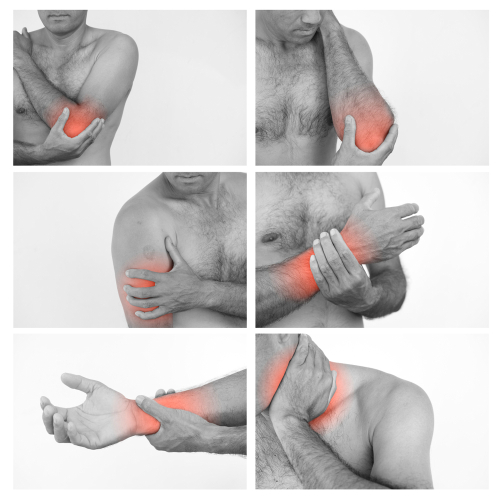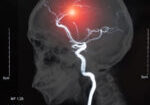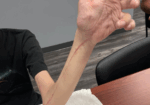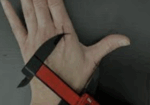What is the incidence of musculoskeletal complaints in the elbow, shoulder, and neck after hand and forearm injuries?
Filed under Reviews
Winiarski, L. M., Livoni, J. D., Madsen, P. V., Rathleff, M. S., & Larsen, P. (2021). Concurrent musculoskeletal complaints in elbows, shoulders, and necks after common hand and forearm injuries or conditions: A cross-sectional study among 600 patients. Journal of hand therapy: official journal of the American Society of Hand Therapists, 34(4), 543–548. https://doi.org/10.1016/j.jht.2020.05.002

The Skinny:
The authors looked to determine what the incidence of shoulder elbow and neck pain after sustaining a typical hand and forearm injury. Isolated hand injuries account for 20-29% of hand and forearm injuries in emergency rooms and orthopedic departments. Oftentimes pain associated in the upper quadrant beyond the injury is neglected and ignored. The authors hoped to bring awareness to these concurrent musculoskeletal issues.
In the Weeds:
The authors used a cross-sectional study. The study used patients that were referred to the shoulder elbow hand therapy department for an isolated hand or forearm injury. The patients were asked two basic questions.
1.) do you currently have pain and/or stiffness in the elbow, shoulder, or neck?
If yes then,
2.) did the symptoms develop before or after their hand and forearm injury?
If the patient answered yes to question 1 and stated the symptoms developed after the hand or forearm injury they were included in the study.
Bringing it Home:
The study took place for 15 months and a total of 600 patients met the eligibility requirements. The average age of patients was 49.1 years with the largest diagnostic group being distal radius and ulna fractures, ligament lesions in fingers (16%), finger fractures (14%). The common areas of concurrent pain were the shoulder (62%), elbow (49%), and the neck (32%”). Thirty-eight percent of patient reports multiple areas of musculoskeletal or stiffness in two or three regions of the upper quadrant and neck.
Rating 4/5.
The study brings attention to the continued need to address the entire upper quadrant when a patient sustains a hand, wrist, or forearm injury. In the future, it would be helpful to publish outcomes after addressing the musculoskeletal impairments to help justify the need for occupational and physical therapy services to prevent long-term pathologies.
2 Comments
Leave a Comment
More To Read
Video-augmented mirror therapy for upper extremity rehabilitation after stroke
Kim, H., Kim, J., Jo, S., Lee, K., Kim, J., & Song, C. (2023). Video augmented mirror therapy for upper extremity rehabilitation after stroke: a randomized controlled trial. Journal of Neurology, 270(2), 831-842. Article Review: Shannon Skowbo The Skinny: This single-blind, randomized control trial aimed to assess the effects of mirror therapy for stroke patients…
Read MoreArteriovenous Malformation (AVM hand)
By: Amalia Garcia Introduction After completing three weeks of my Level II hand therapy rotation, I have seen a wide variety of common upper extremity injuries such as carpal tunnel syndrome, distal radius fractures, mallet finger, flexor tendon lacerations, arthritis, and more. One condition that stood out to me was one that I hadn’t heard…
Read MoreTHUMB ABDUCTION IN PATIENTS WITH CMC ARTHRITIS? HOW DO YOU MEASURE?
Article Review THUMB ABDUCTION IN PATIENTS WITH CMC ARTHRITIS? HOW DO YOU MEASURE? Corey McGee PhD, OTR/L, CHT , Virginia O’Brien OTD, OTR/L, CHT , Jennifer Skye MS, OTR/L, CHT , Katherine Wall MOT, OTR/L , Thumb Carpometacarpal Palmar and CMC Radial Abduction in Adults with Thumb Carpometacarpal Joint Pain: Inter-rater Reliability and Precision of…
Read MoreClosed Pulley Injuries in Rock Climbers
Mechanism of injury Grades of pulley injury Treatment options for closed rupture Outcome measures Return to climbing Exercise considerations Resources Bollen S. R. (1990). Upper limb injuries in elite rock climbers. Journal of the Royal College of Surgeons of Edinburgh, 35(6 Suppl), S18–S20. Bosco, F., Giustra, F., Lusso, A., Faccenda, C., Artiaco, S., & Massè, A. (2022).…
Read MoreSign-up to Get Updates Straight to Your Inbox!
Sign up with us and we will send you regular blog posts on everything hand therapy, notices every time we upload new videos and tutorials, along with handout, protocols, and other useful information.







Thank you for this article. Trying to justify therapy beyond the specific joint a patient is brought in for can be frustrating. We need more research like this.
Great, good article.
At times patients are not necessarily believed and areas of discomfort are neglected. We forget there is fascia, and dermatomes that connect all structures, and will affect above or below the injured site.